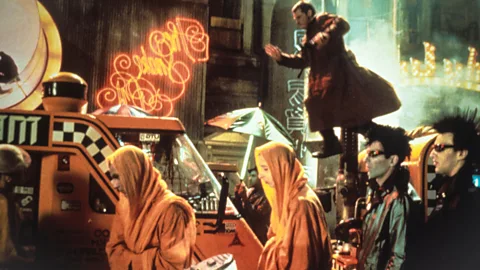The Matrix and the sci-fi stories that predicted life in 2021
 Alamy
AlamyThe dystopian movement known as cyberpunk is bigger than ever. But as the genre's greatest film franchise returns, is truth stranger than fiction, asks Sam Davies.
When was the peak of human civilisation? 1999, according to Agent Smith, the villainous computer program in The Matrix (1999). In the sci-fi series' iconic first film, humans have been enslaved by artificial intelligence 200 years in the future, and what they believe to be the real world is in fact a simulation. Agent Smith explains that the virtual reality – the titular Matrix – they have been tasked with upholding has been modelled on the end of the 20th Century for this reason. After that, it was all downhill for our species, apparently.
Looking back now, you could argue that Smith had a point. Economies were booming. 9/11 hadn't happened yet. Pandemics were a distant memory.
 Alamy
AlamyIt was certainly a peak of cinema: 1999 saw Hollywood films – as superficially varied as Fight Club, Office Space, Being John Malkovich and yes, The Matrix – prod at society's brittle facade, making us question our world, our reality, our very existence. The Matrix was so influential it convinced some fans that its central premise was real. In this year's documentary A Glitch in the Matrix, director Rodney Ascher interviews a whole cast of people who believe that very thing, that we are in fact in the Matrix. The Wachowski sisters' film was also a definitive work of cyberpunk, the noirish subgenre of science fiction where futuristic technologies combine with bleak, dystopian societies.
It is adored to this day, as evidenced by the mania surrounding the release of a new Matrix instalment – The Matrix Resurrections – later this month, with fans even seeming to have forgotten the two dreary sequels that came before it (both released in 2003). As per its title, the fourth film in the series promises to bring three of its most beloved characters back from the dead, with romantically-inclined hackers Neo (Keanu Reeves) and Trinity (Carrie-Anne Moss) having both seemingly died in the third film, while the bespectacled revolutionary Morpheus (Laurence Fishburne) was killed in the canonical narrative of the video-game series The Matrix Online.
All three are set to return (albeit with Morpheus in younger form, this time played by Yahya Abdul-Mateen II), along with the franchise's trademark kung-fu action sequences and an examination of "what is real". With only some cryptic trailers to go on so far, it's anyone's guess where the story goes from here, but the Matrix's central ideas (virtual reality, simulation theory) are more ingrained in our own reality now than ever before. Indeed, in a world where truth is stranger than science fiction, what can a new Matrix film – and the cyberpunk genre as a whole – offer us now?
The origins of cyberpunk
The term cyberpunk was coined in 1983 when US author Bruce Bethke wrote Cyberpunk, a short story in which a group of rebellious kids living in a technologically-advanced society skip school and rob a bank by hacking into its mainframe. Bethke explained that he wanted a term that paired technology with "socially misdirected youth, and tried out the various combinations until one just plain sounded right". Another key early cyberpunk author was Philip K Dick: though his 1968 novel Do Androids Dream of Electric Sheep prefigured the genre, when it was adapted for the big screen under the new name Blade Runner in 1982, the film became one of cyberpunk's most immortal works. Other formative cyberpunk creations include the Japanese manga series Akira (1982) and anime film of the same name (1988), William Gibson's novel Neuromancer (1984) and Mike Pondsmith's role-playing board game Cyberpunk 2020 (1988).
When it arrived in the 1980s, cyberpunk was to mainstream science fiction what punk bands were to prog rockers. Where H G Wells and Arthur C Clarke blasted off into space in search of extraterrestrial life, Gibson and co poked around in the dark, derelict world that was left behind. Though it pulsated with futuristic technology, cyberpunk portrayed a dilapidated society with vast disparities between rich and poor, rampant crime and drug use, corrupt governments whose power was dwarfed by that of megacorporations and an atmosphere thick with pollution, following untold climate disasters. The best definition of the genre is the simplest: high tech, low life.
Another recurring motif, one that lends cyberpunk its punk spirit, is that of state-of-the-art technologies being co-opted and repurposed by subcultural rebels, like Neo and co using simulation tech in The Matrix. "I think one of the key elements is the notion that 'the street finds its own uses for things'," as cyberpunk author Neal Stephenson puts it, quoting from his peer William Gibson's 1982 short story Burning Chrome. His point is that cyberpunk authors are interested not only in predicting future technologies, but also in guessing their often renegade uses. "When electricity became widely available, and lots of things got electrified, the engineers who were envisioning the future were naturally thinking in of electric washing machines, or toasters, maybe even… cars. But I don't think any of them thought of the electric guitar," Stephenson tells BBC Culture. "And even if they had, they probably wouldn't have guessed that it would catalyse an enormously powerful movement in popular music."
 Alamy
Alamy"If you had predicted all that in a novel in say 1920... people would have found it quite... bizarre," he continues. "But it's exactly what happened. So electric guitars are, in my way of thinking, classically cyberpunk phenomena. The challenge is to try to imagine something as bizarre and hard to predict as that, and get people to believe it could really happen." Stephenson knows more about cyberpunk than most ("I've heard of it," he says, with typical dryness): his 1992 novel Snow Crash, set partly in a metaverse (of which more later), is another of the genre's foundational works.
He speaks over video call from his home in Seattle, his connection hampered by an incoming storm that's about to devastate much of the US upper west coast. This and his tendency to take long, thoughtful pauses in the middle of sentences give his voice a slightly robotic edge.
It may now be decades old, but cyberpunk is booming. /r/cyberpunk, a Subreddit dedicated to the genre, has over 620,000 subscribers and counting. Inspired by Pondsmith's tabletop role-playing game, Cyberpunk 2077 – where players roam a lawless city 50 years in the future – is among the most popular video games of recent years, selling more than 10 million copies within a month of its launch in December 2020. One of its characters (Johnny Silverhand, played by The Matrix's Keanu Reeves) even inspired the non-profit organisation Limbitless to 3D-print a version of the character's bionic arm for real-world amputees.
Meanwhile in recent years cyberpunk TV series like Blade Runner: Black Lotus, Cowboy Bebop, Altered Carbon, Omniscient, 3% and Ad Vitam have all hit streaming services. Even in music, cyberpunk's influence is clear: videos for pop hits like Lil Nas X's Panini and Doja Cat's Need to Know place their stars in murky alleyways and seedy nightclubs, as flying cars and holograms drift overhead. The future is here – and it looks just like the 1980s.
What is fuelling our cyberpunk obsession? Perhaps our society is now so similar to those portrayed in the genre that we've become transfixed gazing at our own reflection, making works of cyberpunk feel less like science fiction and more like a crystal ball. Curiously, we're now living in exactly the era that many of cyberpunk's original creators were looking towards. Blade Runner and Akira are both set in 2019. Cyberpunk 2020 is set in 2020. Johnny Mnemonic, the 1981 William Gibson short story and later 1995 film (again starring the face of cyberpunk Keanu Reeves), is set in 2021. Our skies remain largely free of flying cars, and cyborgs have yet to integrate into society. But in many other ways cyberpunk, its ideas and its inventions are more real now than ever.
Long before they entered mainstream public consciousness, ideas like cyberspace, augmented reality, megacorps, transhumanism and – 2021 buzz-concept – the metaverse were fictional inventions in cyberpunk texts.
The concepts that took over the world
Gibson coined the word "cyberspace" in Burning Chrome, before popularising the term with 1984 novel Neuromancer, a cult hit in which hacker Henry Dorsett Case takes on a shady mission in a virtual reality dataspace called the matrix. "A consensual hallucination experienced daily by billions of legitimate operators," is how Gibson describes it in an often-quoted age that many see as having prefaced the World Wide Web. Gibson also popularised the term "megacorp", referring to a conglomerate with monopolistic power over numerous markets, so vast that its influence over society eclipses that of any government.
Some would suggest these megacorps are now very much a reality, run by moguls who have more power than presidents. The most powerful man in Snow Crash is L Bob Rife, a media tycoon who proclaims to "deal in information", controlling the world's television and the network through which the metaverse runs. He's also accused of spying on his employees and using their private information against them. Stephenson says the real world is yet to produce anyone quite as omnipotent as Rife, "but somehow we have reached a state where we, as a society, now look to billionaires as... problem solvers". Stephenson's own CV includes working as a "futurist" at Blue Origin, an aerospace company founded by Jeff Bezos, with whom Stephenson maintains sporadic .
 Alamy
AlamyVirtual-reality headsets, as seen in The Matrix, Neuromancer, Johnny Mnemonic and many other works of cyberpunk, have become especially popular during the pandemic, allowing people to attend gigs, festivals, exercise classes, Black Lives Matter protests and even surgical training without leaving their homes. Augmented reality, traceable as far back as Philip K Dick's 1956 short story The Minority Report, and running through cyberpunk works from Neuromancer to Paul Verhoeven's 1987 movie RoboCop, is one of the fastest growing technologies in the world, with the approaching mainstream arrival of AR glasses and AR lenses.
The principle of deepfakes – digitally altering a person's identity to deceive a viewer – can be seen in The Running Man, the 1987 cyberpunk film (set in 2017) where a TV corporation uses "digital matte tracking" to frame Arnold Schwarzenegger's rogue army man for crimes he didn't commit. Cryptocurrency, meanwhile, was prefaced in Neal Stephenson's 1999 novel Cryptonomicon (and Stephenson has even been wryly suggested as the real person behind Satoshi Nakamoto, the pseudonymous inventor of Bitcoin).
But what if, as speculative author Jack Womack writes in the afterword of Neuromancer's 2000 US reprint, "the act of writing it down, in fact, brought it about">window._taboola = window._taboola || []; _taboola.push({ mode: 'alternating-thumbnails-a', container: 'taboola-below-article', placement: 'Below Article', target_type: 'mix' });
